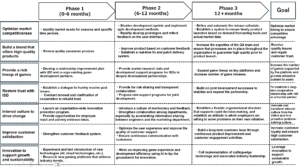Introduction
In this article, as head of marketing for Nova Enterprise, a company that sells and promotes home gaming platforms and software products, we will consider how IT can be used to achieve IT Goals both short- and long-term. First, briefly, though, the U.S. video game market,
Market Size
In 2024, the overall U.S. video game market is worth 61.96 billion.Restricted to the video game console market, it was worth $26.65 billion in 2023 and is projected to grow to $55.36 billion by 2032, a compound annual growth rate (CAGR) of 8.46
Market Segments
Home consoles dominate the market, accounting for 63% of the console market in 2023, with popular console brands such as PlayStation, Xbox, and Nintendo Switch offering high-performance gaming experiences and exclusive titles.
The market is shifting toward digital content distribution, with publishers focusing on digital distribution of games and services. Cloud gaming and the emergence of portable gaming systems like Steam Deck are areas to watch in the home gaming space.
Nova has one of the highest technological innovation powers in the industry, but has the lowest market share in the U.S. video game market. And to compete with Sony PlayStation and Nintendo Switch, the main challenges were as follows
・The timing of the launch of games: The timing of product introduction was poor, and sometimes products were not in the market even though there was demand for them. For example, their Dreamweaver product had better performance than Sony’s PlayStation V and Nintendo’s Nintendo Switch, but they were missing out on customers due to the delay in the launch.
・The Quality Issues: The company’s own game, Dreamweaver, was multifunctional but had many bugs, resulting in a string of returned products. This resulted in a rapid deterioration of the company’s reputation in the market.
・The lack of software: The company’s development department had excellent human resources, but the number of games it could offer was limited. Even after introducing a new home-use platform, the company’s competitiveness was weak, especially when there were only eight games that were compatible with the new platform.
・The company’s relationship with independent game developers (ISD): The company’s trust relationship with ISD had been damaged by the cancellation of the Realforce project in the past. In addition, ISD was hesitant to develop games for Nova because the market research department insisted on the demand for low-priced children’s games, but could not provide a concrete market size.
・ Working with a new VP of Marketing: The new VP of Marketing came from an advertising agency and was unfamiliar with the realities of the industry. Lack of concrete support for change within the company, focusing only on brand image and advertising campaigns.
・ Internal culture issues: The CEO and technical staff were satisfied with the status quo and were not actively engaged in solving problems.
Define your desired state

The ideal Nova Enterprise should be built on the following elements. These are the directions in which the strategic goals of the enterprise should be achieved through problem-solving and organizational transformation.
- Strong market competitiveness
Optimize market timing: Nova Enterprise should be positioned as a company that can optimize the timing of product launches and bring products to market ahead of competitors. This will demonstrate not only its technological prowess but also its ability to meet customer needs in a timely manner.
◆ Adopt agile development and demand forecasting tools to shorten release cycles and ensure competitive advantage.
- A brand that delivers high-quality products
Improve product quality: Address quality issues and eliminate defects, especially in products such as “Dreamweaver. By providing high-performance products with fewer bugs, the brand will regain credibility.
◆ Strengthen quality assurance: Ensure product quality through automated testing and user feedback.
◆ Build on customer trust with real-time fixes and update delivery.
- Provide a rich game lineup
Diversified game titles: Provide users with compelling content by significantly increasing the lineup of games for new platforms.
◆ Build strong partnerships with independent game developers (ISDs) and promote collaboration. They will also provide development support and market research data to create an environment in which ISDs can develop games with confidence.
- Position as a trusted partner
Restore trust with ISD: Restore trust damaged by past project cancellations and pave the way for joint development. Building a trustworthy partnership will lead to a long-term competitive advantage.
◆ Provide transparency and flexible collaboration, and deepen cooperation with ISD while sharing risks.
- An internal culture that promotes change
Innovation-driven internal culture: We will change a culture that emphasizes maintaining the status quo and foster a culture in which all employees are actively engaged in problem-solving. Transform into a flexible organization that welcomes new ideas and technological innovation and makes decisions quickly.
◆ Adopt a results-oriented and open feedback culture to motivate employees and encourage team collaboration.
◆ They will strengthen collaboration between engineers and the marketing department to improve the market adaptability of our products.
- Improve customer satisfaction
Improve the user experience: Focus on optimizing the user experience by prioritizing the features and value that customers seek. This will result in long-term customer loyalty.
◆Through regular user surveys and feedback systems, customer feedback will be reflected in our products for continuous improvement.
- Innovation to support growth and sustainability
Innovation and competitiveness: Maintain industry-leading innovation capabilities and leverage new technologies to gain a competitive advantage. Establish ourselves as an industry leader by introducing new platforms and gaming technologies.
◆ Leverage AI and cloud technologies to improve game playing experience and development efficiency to support sustainable growth.
Plan your roadmap
The following detailed RoadMap is required to achieve Nova Enterprise’s Tobe (ideal state). Each step has clearly defined goals to be realized and an action plan to be implemented, and by working on each step in sequence, we can ultimately grow into a strong, competitive, and trusted enterprise.
Roadmap:

Based on the roadmap, Nova Enterprise can respond quickly to short-term challenges and make steady progress toward its long-term goals. By implementing each step in sequence, tracking results, and flexibly adjusting strategies, Nova Enterprise will be able to realize its Tobe (ideal company image).
Implement your actions
This is a concrete action plan for Nova Enterprise to realize its Tobe (ideal corporate image). For each goal, we propose specific actions to be taken in the short, medium, and long-term phases.

Communicate your results

Clear results from Nova Enterprise’s implementation of short- and long-term action plans can be effectively communicated both internally and externally, leading to increased trust and market advantage. Managing these results based on KPIs (Key Performance Indicators) and KSFs (Key Success Factors) and effectively evaluating progress can promote further growth. Transparency and quantitative evaluation of results are essential for understanding the strategic direction of the company. Achieving goals such as increasing market competitiveness, improving quality, providing richer content, and restoring partnerships with ISD will require setting KPIs and quantitatively measuring progress. For example, proper management of KPIs such as sales growth, customer satisfaction, bug fix rate, and on-time delivery rate can improve stakeholder and partner confidence and lead to expectations for further cooperation and investment. For example, the market data analysis tool introduced in the short-term measures has improved the accuracy of demand forecasting and the timing of product releases earlier than competitors. This has resulted in a XX% year-on-year increase in the sales growth rate (KPI). In addition, enhanced quality assurance processes have reduced Dreamweaver’s initial bugs by XX% and customer return rates by XX% (KPI). Furthermore, in terms of KSFs, internal decision-making speed was improved and communication between teams was strengthened. These achievements were shared in regular reports, internal presentations, and press releases to ensure transparency of the results, which improved internal morale and ensured that the company could communicate its reputation to the market. Thus, by clearly and effectively communicating results, Nova Enterprise has proven its ability to execute its corporate strategy and strengthen its credibility and competitive advantage; by properly setting and managing KPIs and KSFs, it has maintained transparency of results and established a foundation for future growth and sustainability.
Review your strategy

For a company like Nova Enterprise that is aiming for rapid growth, the future depends not on the execution of the strategy itself, but on the “introspection” of what to learn from the strategy and how to apply it in the next phase. The future of a company such as Nova Enterprise depends on introspective action.
While Nova’s efforts are expected to yield short-term results, such as optimizing release timing and automating quality assurance, long-term strategies, such as rebuilding trust with ISD and cultural change, tend to lag in evaluation due to the lack of visibility of quantitative results. To compensate for this asymmetry, it is essential to incorporate a post-implementation review system and evaluation criteria in advance.
For example, how the product was received in the market after release should be verified using indicators such as customer feedback and return rates, and a multifaceted analysis should be conducted to determine which measures were most effective. In addition, in building relationships with ISDs, not only the number of contracts and project completion rates, but also subjective trust indicators from ISDs (NPS and level of cooperation) should be monitored.
Even more important is a mechanism to accumulate the results of such introspection as an internal knowledge asset and incorporate them into the next decision-making process. For example, “look-back sprints” and “periodic cross-functional reviews” should be incorporated into the agile development process to ensure that suggestions from the field flow back into management decision-making.
For Nova Enterprise, “looking back on strategy” is not just a review process, but a “learning and change device” that influences future competitiveness. By placing reflection at the center of the organizational culture as a bridge between the short-term and long-term time frames, IT strategy will be elevated to a truly sustainable and value-creating form.
Concluding Remarks.
As the Nova Enterprise case study demonstrates, to build long-term competitiveness and credibility while pursuing short-term results, it is essential to have a “precise understanding of the current state,” “a clear vision of where the company should be,” “a step-by-step roadmap and implementation,” and “continuous evaluation and flexible adjustments. ”IT strategy is not just technology implementation, but is deeply involved in overall corporate activities, including organizational culture, partnerships, and customer understanding. The key to making IT a true growth engine is not to fixate on short-term goals but to continually reevaluate the strategy with an eye to the future.
This website also introduces other business-related insights we have developed, such as market analysis and IT innovation-related matters. If you are interested, please read on. (https://www.heart-desire.co/category/insight/)
The Wonderful Travel Tips
Yuichi Yokoyama



コメント